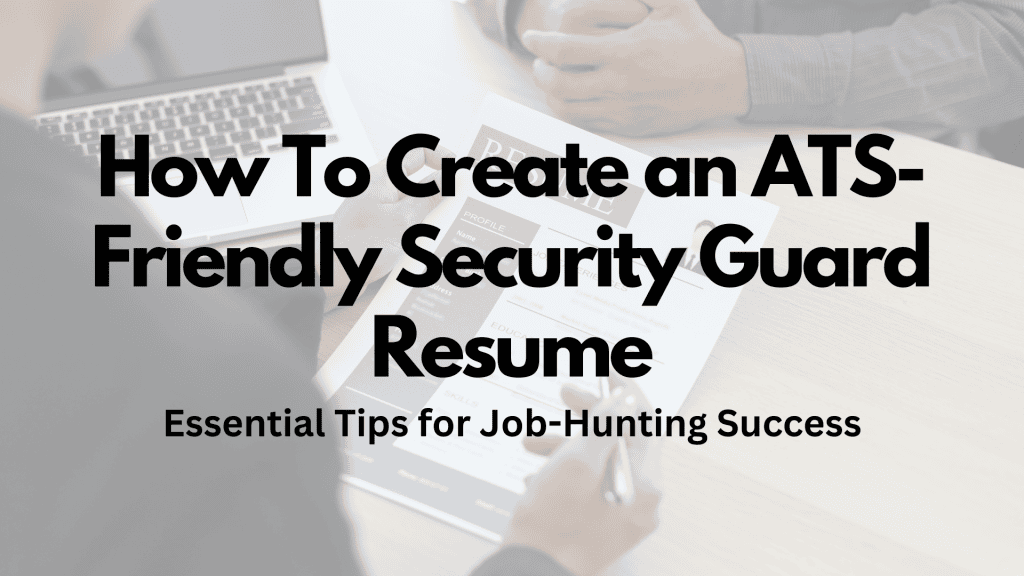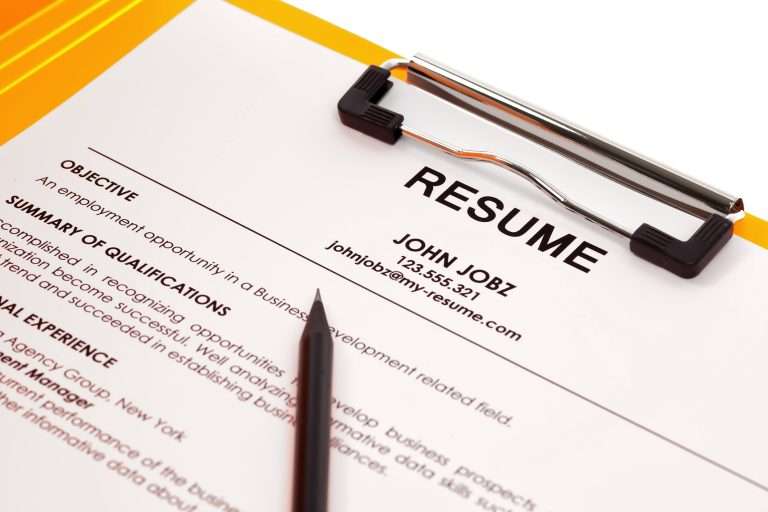How To Create an ATS Friendly Resume For Security Guards – Essential Tips for Success
Crafting a resume as a security guard that stands out to recruiters involves understanding how to navigate Applicant Tracking Systems (ATS) and make an ATS friendly resume.
These systems are programmed to evaluate resumes based on specific keywords and formatting, which can often be a barrier to getting your application seen by human eyes.
To improve your chances of making it through the initial digital screening, it’s essential to optimize your security guard resume for ATS compatibility while keeping it engaging for the eventual human reader.
Your resume objective serves as your elevator pitch, succinctly summarizing your professional aspirations, relevant qualifications, and the unique value you bring to potential employers.
By tailoring this section to align with the requirements of the security guard role, you not only capture the attention of the ATS but also establish your intent and professional focus to the hiring manager reviewing your application.
Employing a straightforward structure and including pertinent keywords throughout your resume will enhance its visibility in ATS searches without sacrificing clarity.
Simplicity in design and consistency in formatting ensure that the system can accurately parse your information, increasing the likelihood that your qualifications will be effectively presented to the decision-makers.
In the competitive field of security, paying attention to these details can make a difference in landing your next opportunity.

Understanding ATS Friendly Resumes
In crafting your security guard resume, it's essential to ensure that it's not only reflective of your skills but also that it's formatted to be compatible with Applicant Tracking Systems (ATS).
Why ATS Compatibility is Crucial
ATS systems are frequently used by employers to filter and rank candidates' resumes.
Your resume needs to be ATS friendly to ensure it reaches a human recruiter. If you do not format your security guard resume with ATS compatibility in mind, you risk being overlooked regardless of your qualifications.
- ATS Friendly Resume Format: Use a straightforward format with clear headings and avoid fancy graphics or columns, which can confuse ATS.
- Keywords: Integrate keywords from the job description relating to security guard responsibilities; ATS algorithms often scan for these.
How ATS Algorithms Work
ATS algorithms parse and evaluate resumes based on how closely they align with job postings.
To make your resume stand out:
- Choose the Right Keywords: Leverage job-related terms and skills that are likely to be programmed into the ATS for a security guard position.
- Structured Resume Format: Present your information in a logical order.
- Contact Information should be at the top followed by:
- Summary or Objective,
- Work Experience in reverse-chronological order,
- Education, and
- Skills section.
By knowing how an ATS works and formatting your security guard resume accordingly, you increase your chances of making it past the initial screening.
Starting With a Strong Header
Your resume's header is the first thing a prospective employer will see, so it must be neatly organized and convey essential personal and contact information at a glance.
Personal Details
Your Full Name should be prominently displayed at the top of the resume, usually in a larger font than the rest of the text.
It's vital to ensure that this stands out as the focal point of the header. Here is an example of how to format your name:
- John Doe
Position your Location just below your name. Include your city and state to give employers an idea of your proximity to the job site without the need for full address details. For example:
- Regina, SK
Contact Information
Effective communication is key, so your Contact Information must be clear and accessible.
Provide your Phone Number using a consistent format, and whether you choose to use periods, hyphens, or spaces, ensure it is easy to read. Your Phone Number should look like:
- 555-123-4567
Finally, list a professional Email Address that includes your name for easy reference.
Avoid using nicknames or numbers that may make you seem less professional. An example of a suitable email address is:
- john.doe@example.com
Crafting a Compelling Resume Summary
A resume summary showcases your qualifications and career achievements, capturing the attention of hiring managers and allowing your application to make a strong first impression.
Showcasing Your Value
When constructing your Resume Summary, focus on your tangible achievements and experience.
Start by confidently stating your years of experience in the security industry, followed by a quick mention of your most relevant qualifications. For example:
- Years of Experience: “With over 10 years in the security field…”
- Key Qualifications: “…certified in risk management and advanced surveillance techniques.”
Be specific about what you bring to the table. If you’ve reduced incident rates or successfully led teams, include metrics to quantify your achievements:
- Incident Rate Reduction: “Achieved a 20% reduction in security breaches…”
- Leadership: “…and led a team of 15 security personnel.”
Summary Versus Objective
A Resume Summary differs from a Career Objective as it focuses on discussing what you’ve already accomplished professionally and how it aligns with the role you’re applying for.
In contrast, a career objective states what you hope to achieve and what goals you have. It is more suitable for entry-level applicants or career changers.
Your summary should be a bridge between your past experiences and the prospective role. For instance:
- “Expert security guard with a track record in…seeks to leverage…”
- “Dedicated professional adept at…aiming to contribute to…”
Remember, your Profile in the summary is a brief and high-impact pitch about your professional self.
Make every word count, and tailor your summary to each job application, ensuring that your skills match the job description.
Highlighting Security Guard Skills
To ensure your resume passes the Applicant Tracking System (ATS) and catches the eye of recruiters, focus on showcasing specific security guard skills that demonstrate your capabilities in the field.
Your resume should illustrate the expertise you bring to the table, separating your hard and soft skills.
Hard Skills
When highlighting your hard skills, detail your proficiency in areas such as:
- Surveillance: Note your experience with CCTV operations, monitoring software, and reporting irregularities.
- Emergency Response: Describe your competency in first aid, CPR, evacuation procedures, and incident reporting.
- Safety Protocol Compliance: Emphasize your knowledge of industry regulations and company policies.
- Report Writing: Point out your ability to create detailed reports that document occurrences during your shift.
| Hard Skill | Brief Description |
|---|---|
| Surveillance | Proficient in operating and monitoring CCTV systems; experienced in identifying suspicious activities and maintaining surveillance logs. |
| Emergency Response | Trained in emergency procedures, including first aid and CPR; skilled in incident documentation and response. |
| Safety Protocol Compliance | Familiar with safety regulations; ensures adherence to company protocols and industry standards. |
| Report Writing | Capable of producing clear, concise, and detailed written reports on shift events and discrepancies. |
Soft Skills
Your soft skills are just as crucial as your technical abilities. On your resume, include:
- Communication: Showcase your ability to interact effectively with colleagues, management, and the public.
- Detail Orientation: Convey your attentiveness to details and capacity for noticing inconsistencies or security breaches.
- Problem-Solving: Highlight how you approach complex situations and resolve conflicts or issues.
- Vigilance: Demonstrate your constant alertness and awareness of the surroundings.
| Soft Skill | Brief Description |
|---|---|
| Communication | Clear communicator, capable of de-escalating situations and providing essential information to stakeholders. |
| Detail Orientation | Attentive to detail, ensures thorough security checks and identifies security risks efficiently. |
| Problem-Solving | Resolves conflicts and navigates complex situations with sound judgment. |
| Vigilance | Remain vigilant and alert during patrols to maintain security and safety. |
Detailing Your Work Experience
When crafting your work experience section, clarity and relevance are key. Your ability to detail the pertinent aspects of your past roles could be the difference in catching a recruiter's eye.
Specifying Security Roles
Your Employment History should begin with the most recent Security Guard Job Description and work backwards.
- Security Officer, XYZ Corporation, May 2019 – Present
- Patrol Officer, ABC Agency, Jan 2017 – Apr 2019
- Security Guard, DEF Services, Oct 2014 – Dec 2016
Highlight the specific title of each position, for example:
Elaborate on the scope of your roles to illustrate the breadth of your experience. For instance, mention if you were responsible for monitoring a commercial property or part of a personal security detail.
Utilizing Bullet Points
For each role, use bullet points to list your duties and Achievements.
This format makes it easy for hiring managers to quickly scan your resume.
Be concise and use Action Verbs to start each point:
- Monitored CCTV systems to ensure the safety of personnel and prevent unauthorized access.
- Managed access control for a 20-story office building.
- Trained 15 new hires in security protocols and emergency response techniques.
Incorporating Metrics
Quantify your accomplishments with metrics where possible. This helps to provide context and demonstrates the tangible impact you've had in your roles. Examples include:
- Reduced security incidents by 25% through the implementation of a new surveillance protocol.
- Oversaw a team of 10 security personnel daily.
- Conducted security audits resulting in a 30% improvement in efficiency.
Including Relevant Education
When crafting your security guard resume for ATS systems, it's crucial to list your education credibly and concisely.
Academic Achievements
Your High School Diploma should be prominently listed, especially if it's your highest level of formal education. If you possess further educational qualifications, these should also be included. Format this information. For example:
- High School Diploma: [Your School's Name], [Year of Graduation]
- Bachelor's Degree: [Degree Title, if applicable] – [University Name], [Year of Graduation]
If you have security-related Certifications, such as a Certified Protection Professional (CPP) or Professional Certified Investigator (PCI), they merit a special mention.
For ATS compatibility, be sure to spell out the full name of the certification followed by the acronym in parentheses. For instance:
- Certifications:
- Use of Force (UoF) – [Issuing Organization], [Year]
- Standard First-Aid/CPR (CPR) – [Issuing Organization], [Year]
Under Additional Training, include any courses or workshops you've completed that pertain to the role of a security guard.
This could encompass areas like surveillance techniques, first aid, or crisis management. Present this information as follows:
- Additional Training:
- Advanced Surveillance Techniques – [Training Provider], [Year]
- Situational Awareness Training – [Issuing Organization], [Year]
- Crisis Management Workshop – [Training Provider], [Year]
Showcasing Certifications and Licenses
Your resume should highlight your certifications and licenses, as they are crucial for a security guard position.
Security Guard License
If you are a licensed security guard, whether armed or unarmed, specify the type of license you hold and the province in which you are licensed.
- Province-Issued Security Guard License:
- Issuing State: [Your Province]
- License Number: [Your License Number]
- Expiration Date: [License Expiration Date]
Make sure to keep this section updated with any renewal information as well.
Other Relevant Certifications
In addition to your security guard license, include any other certifications that enhance your eligibility for the role.
These might include first aid, CPR, or specialized security training.
Presenting a comprehensive list of relevant certifications will underscore your expertise and commitment to the profession.
- First Aid Certification
- CPR Certification
- Advanced Security Training
- Conflict Resolution Certification
- Baton/Handcuff Training (if applicable)
Remember, each entry should have the name of the certification, the issuing organization, and the date of expiry if applicable.
Adding Professional Affiliations
Your resume can stand out to Applicant Tracking Systems (ATS) and employers by including professional affiliations related to security and law enforcement.
Advantages of Professional Networks
Being part of a professional network can significantly enhance your resume's appeal.
As a security guard, membership in recognized organizations demonstrates continuous learning and commitment to your field.
Networking opportunities provided by these affiliations are invaluable, allowing you to connect with peers, stay informed on industry best practices, and access resources that can aid in career advancement.
Security Associations and Memberships
Incorporate a list of pertinent security associations and memberships to emphasize your dedication and professional engagement within the sector.
- National Associations: Such as ASIS International, the National Association of Security Companies (NASCO), and the International Foundation for Protection Officers (IFPO). These memberships showcase your alignment with industry standards.
- Provincial and Local Organizations: Being a member of regional law enforcement and security associations signals your active participation and awareness of local security issues and regulations.
- Specialized Groups: If your experience includes specific areas like cybersecurity or executive protection, displaying your affiliations with specialized groups can set you apart as a knowledgeable candidate in those niches.
To organize your affiliations effectively, use a simple table format:
| Association Name | Membership Duration | Position (if any) |
|---|---|---|
| ASIS International | 2018 – Present | Member |
| International Foundation for Protection Officers | 2019 – Present | Member |
| Local Law Enforcement Association | 2020 – Present | Treasurer |
Remember, mention only current memberships and any relevant positions you've held within these organizations, as this adds credibility and displays your proactive role in your professional community.
Incorporating Additional Sections
By adding sections for your awards, volunteer experience, and hobbies and interests, you enhance your resume by showcasing your personal achievements and community involvement.
These sections demonstrate your character beyond professional skills and security guard responsibilities.
Awards and Accomplishments
List any awards or recognitions you have received that are relevant to security work or demonstrate your dedication and excellence. This can include:
- Employee of the Month
- Certificates of Achievement
- Security-related commendations
Format these in a bullet list, mentioning the award, issuing organization, and date received.
Volunteer Experience
Outline your volunteer work, particularly if it relates to security, safety, or community service. For instance:
- Neighborhood Watch Program (March 2021 – Present)
- Event Security Volunteer for local marathons (June 2022 – Present)
Include the organization's name, the role you filled, and the duration of your service.
Hobbies and Interests
Include a concise list of hobbies and interests that demonstrate qualities like vigilance, attention to detail, and physical fitness. For example:
- Chess (strategic thinking)
- Martial Arts (self-discipline and physical readiness)
- Running (stamina and endurance)
Writing a Matching Cover Letter
A successful job application often pairs a well-crafted cover letter with your resume.
It's your chance to make a personal connection with the hiring manager and distinguish yourself from other candidates.
The Importance of a Cover Letter
Your cover letter is an essential tool that introduces you to the hiring manager.
It provides context to your resume by highlighting your relevant skills and expressing your enthusiasm for the security guard position.
More importantly, it’s your opportunity to demonstrate how your background and experiences align with the company’s needs and values.
Cover Letter Format
The structure of a cover letter is straightforward. Here's a simple breakdown:
- Header: Includes your contact information, the date, and the hiring manager's contact information.
- Salutation: Use a formal greeting such as “Dear Hiring Manager,”.
- Introduction: Briefly introduce yourself and state the position you’re applying for.
- Body Paragraphs:
- Explain why you’re a great fit for the role.
- Provide examples of your relevant experience and achievements.
- Closing: Thank the hiring manager for considering your application and indicate your desire for an interview.
- Sign-off: Use a professional closing such as “Sincerely,” followed by your name.
Tailoring to the Job Description
It's critical to customize your cover letter for each application.
Scan the job description, identifying the key responsibilities and requirements.
Map Your Skills to the Job Description:
| Job Description Requirements | Your Matching Skills |
|---|---|
| Vigilance and attention to detail | Experience monitoring CCTV and performing site patrols |
| Communication skills | Effective report writing and incident briefing |
| Crisis management | Quick response to security alerts, ensuring safety protocols are followed |
Ensure your cover letter reflects how your previous work or life experiences have prepared you to excel in these areas.
Adapt your language to mimic the tone and key terms used in the job listing, showing the hiring manager that you're a suitable match for their security team.
Finalizing Your Resume
Once your content is in place, the final steps involve scrutinizing the details and ensuring a clean, professional presentation.
Your resume is a testament to your attention to detail and professionalism, so it's crucial to get it right.
Proofreading and Editing
Check your resume meticulously for any spelling, grammar, or punctuation errors.
Typos can be a major red flag for employers and an ATS system may overlook critical keywords if they are misspelled.
Use tools like Grammarly or have a friend review your resume to catch mistakes you might have missed.
Consistent Formatting
Your resume should have a uniform look with consistent use of bold for headings, italics for emphasis, and bullet points for listing your responsibilities and achievements.
Whether you're using a functional resume or a chronological format, keep your styling uniform throughout.
If you used a resume builder or template, stick to the predefined styles for a professional look.
Getting Feedback
Before you consider your resume complete, seek feedback from mentors, colleagues, or professionals in the security industry.
They can provide insights on whether your resume is aligned with industry expectations and if the content reads well in reverse chronological order or any other chosen format.
This step is invaluable, as it can reveal areas of improvement that you may have overlooked.
Frequently Asked Questions
When crafting an ATS-friendly resume for a security guard position, it is crucial to understand the specific elements that make a resume stand out to both the applicant tracking systems (ATS) and potential employers.
What are the essential elements to include in a resume for a security guard position to ensure it's ATS-friendly?
Your resume should incorporate relevant keywords from the job description, clear section headings such as ‘Experience', ‘Education', and ‘Skills', and a simple, machine-readable format. Avoid graphics and tables, as these can confuse ATS.
How can one highlight security officer skills effectively on an ATS-compliant resume?
Focus on including both soft and hard skills pertinent to security roles.
Use bullet points to list skills like surveillance, report writing, and emergency response, ensuring they align with the language in the job listing.
What is the best way to format a resume for a security guard to maximize ATS compatibility?
Opt for a chronological or hybrid resume format with a clean layout and standard fonts like Arial or Times New Roman.
Maintain a font size between 10 and 12 points and use black text on a white background.
How should someone with no prior experience structure an ATS-friendly resume for a security guard role?
Emphasize education, certifications, and transferable skills such as alertness and integrity.
Place focus on any internships, volunteer work, or activities that demonstrate your suitability for a security role.
Can you suggest a compelling summary for a security guard resume that would appeal to both ATS and recruiters?
Begin with a strong opening statement: “Detail-oriented and vigilant professional with a proven track record in maintaining secure environments.”
Tailor the rest of your summary to match keywords from the security guard job description.
What tips can you provide for converting a security guard resume into an ATS-friendly PDF format?
Ensure all text is selectable and avoid document protection which can restrict ATS from reading your resume.
Convert your resume from a Word document to a PDF through the ‘Save As' function to preserve formatting.
Last Updated on Jul 5, 2024





